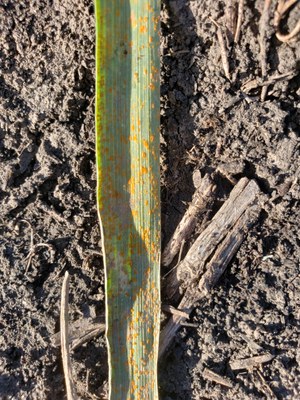Growing Rye as a Cover Crop in North Dakota (A2010, March 2021)
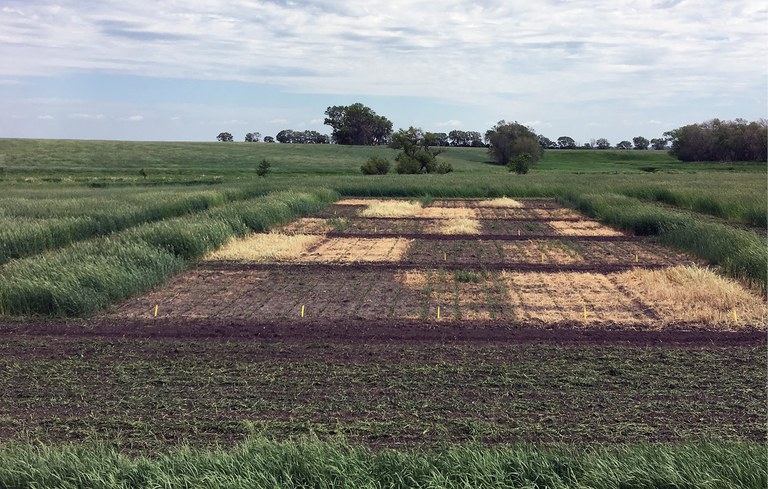
Cover crops can play an important role in sustainable agriculture production, particularly when grown during times of the year when the soil might otherwise be bare. Properly managed cover crops can reduce soil losses from wind and water erosion, reduce nitrogen (N) losses, utilize excessive soil moisture, promote biodiversity, suppress weeds, improve soil structure and improve trafficability of fields.
In temperate regions of the world, rye (Secale cereale) is the most frequently grown cover crop as a sole crop or as a component of a cover crop mix. Rye, sometime referred to as cereal rye, is a cereal crop that when grown to maturity, the grain is used in breads, crackers and brewing, and as an animal feed.
Like wheat, we have spring and winter types of rye, although winter rye is the only type of rye typically grown in North Dakota and is the focus of this publication. Winter rye, when planted in the fall, will go dormant but remain alive during the winter and regrow the following spring.
Winter rye planted in the second half of the summer or fall will not flower until it has been exposed to a prolonged cold period. This requirement is referred to as the vernalization requirement.
The time/temperature requirement for vernalization to occur varies by variety but is usually 30 or more days when soil temperatures are below 45 F. This means that when winter rye is planted in late spring or early summer, it likely will not flower and produce seed, although a few plants may flower within a field that somehow overcame the need for vernalization.
Reasons to select rye as a cover crop:
- More winter hardy than winter wheat
- Is relatively shade tolerant so may establish when interseeded into a maturing crop such as corn, sunflowers, dry beans and soybeans
- Handles poor soil conditions better than most
other cover crops. It is tolerant to aluminum toxicity. Its tolerance to saline soils is similar to oats and barley until the soil electrical conductivity (EC) reaches about 6 millimhos per centimeter (mmhos/cm) (1:1 soil:water EC value) - Has the ability to take up excess N, decreasing
risk of environmental contamination through leaching or runoff - Tolerates cool temperatures, allowing plant growth to continue until soil freeze-up in the fall
- Resumes plant growth early in the spring, so it is ideal for early spring soil cover
- Matures generally one week earlier than winter wheat, although not early enough to allow double cropping with warm-season row crops
- Competes well with weeds and provides allelopathic suppression to some weeds, including foxtails, kochia, pigweeds and marestail
Concerns with rye as a cover crop:
- Growing a rye cover crop before small grain and corn is not recommended due to potential growth inhibition by rye plants in these crops and contamination with volunteer rye seed in other harvested small grains.
- It is prone to seed shattering and it is difficult to clean out of equipment, resulting in increased
seed dispersal and the chance for volunteer rye. - It is susceptible to wheat streak mosaic virus (WSMV) and the wheat curl mite (WCM). However, transmission of WSMV from cereal rye to other susceptible small grains by WCM is relatively low, compared with other grass hosts. It can increase the risk of ergot in small-grain crops the year following its production if it reaches maturity (for example, the rye cover crop is grown for seed production).
- Nitrogen taken up by rye may not be available to the following crop, although it eventually may be utilized by future crops subsequent to the initial following crop.
- Little spring biomass will develop prior to the planting of early spring sown crops that follow the cover, such as field peas or canola.
- It does not survive the winter well when planted in the spring or early summer. It is best adapted for planting in late summer through late fall if spring ground cover is intended the following season.
Management Recommendations
For cover crops to provide a benefit, they must establish sufficient roots and above-ground biomass to achieve the intended benefits. Therefore, the amount of biomass produced by the cover crop is a good indicator of its usefulness to the cropping system.
Research has shown that the benefits of cover crops for weed control and to mitigate N loss increase with biomass and measurable benefits begin with about 500 pounds per acre. When planted after a crop in the fall, this level of biomass may be difficult to achieve, but a well-rooted crop of smaller size still can be valuable to the system. Additionally, growth of rye in the early spring may reach effective biomass levels when the following crops are planted after the middle of May.
To have the greatest benefit, rye covers should be uniform in stand and should develop sufficient leaf area to cover the soil’s surface and develop a root network that extends 4 to 6 inches deep. Minimum biomass levels for other benefits such as erosion control have not been published, though even a partial cover has been observed to greatly help prevent wind erosion.
Variety Selection
Depending on the primary objective for using rye as a cover crop, you may have important varietal characteristics to consider. Planting a variety that is known to be adapted and that can survive the winters in North Dakota is critical.
Certified seed of most varieties is not available in North Dakota. The exception would be the two varieties released by NDSU, ND Dylan and ND Gardner. Information on the performance of varieties that have been tested for grain production in North Dakota can be found at www.ag.ndsu.edu/varietytrials/winter-rye.
North Dakota seed law allows for the sale of rye seed without the specification of the variety (labeled as VNS – variety not stated) if it is a variety that has not been protected under Plant Variety Protection (PVP). However, the law requires that any seed that is sold must be labeled. Official seed testing is required to generate this label, although no specific standards are set as to whether it can be sold as seed.
Varieties of rye that are protected by PVP, such as ND Dylan and ND Gardner, must be sold as a class of certified seed. Certified seed must meet standards of purity and germination. When using seed that is not certified, carefully read the seed label before purchasing because it indicates the types of restricted weeds seeds present and the level of germination.
Purchasing seed produced near your farm may help reduce the risk of introducing new weed species into your farm. Avoid seed lots with ergot because ergot bodies can be a source of future ergot infections when a small grain is grown.
Rye hybrids are available and can have higher yield potential than open-pollinated varieties but testing in North Dakota has not shown that they have a higher biomass potential. Unless taken to grain, however, the extra cost for the hybrid seed is not justified and some hybrids may not survive the winter well because they were developed for environments with less severe cold during the winter.
Planting
- The optimal time to seed rye is the last week of August through early October. Later seedings will produce very little biomass for ground cover in the fall. Seedlings that establish, however, have the potential for early spring development if the intent of the planting is spring ground cover (Figure 1).
- When seeding into standing corn, aerial broadcasting when the crop reaches the dent (R4) stage and the lower leaves start to dry and the canopy starts to open is recommended. Drilling after the V5 stage may allow for successful establishment and growth in seasons when rainfall is adequate.
- When seeding into a soybean crop, aerial broadcast when soybean leaves start to drop (R7 stage).
- When following crops harvested in August or September, plant as soon after harvest as practical.
- Planting rates vary depending on cover crop goals, planting date and methods, soil conditions, seed size and quality, etc. A base rate to consider when planting rye is 1 million live seeds per acre (about 60 pounds per acre) for pure stands. Consider using higher rates when stand establishment might be difficult such as late planting (generally mid-October or later), or challenging soil conditions. The impact of rye planting date and seeding rate on plant density and groundcover in the late spring can be seen from data from experiments in Carrington (Table 1).
- When broadcasting without incorporation, increase the seeding rate by 10 or more pounds per acre. Rye that is broadcast typically will not germinate unless rain falls after sowing.
- When mixing with other cover crop species, reduce the seeding rate of rye by more than 50% because rye easily can become the dominant species if sown at the full rate.
- When planting a mixture of cover crops that include rye, make sure the seed stays mixed or use separate seed boxes.
Figure 1. Rye survived the winter poorly (top) when planted in June, when compared with rye in the same field planted later in the year (bottom). (Joel Ransom, NDSU)
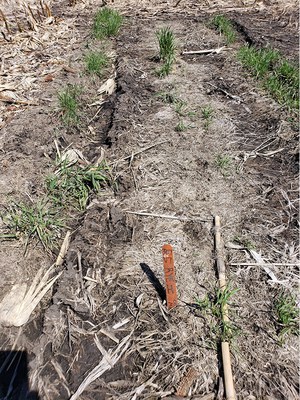
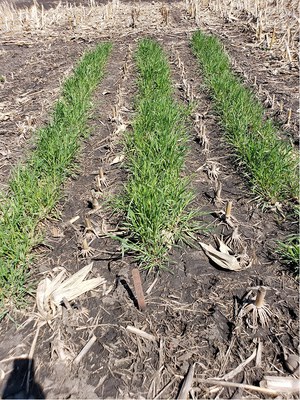
Table 1. Effect of planting date and seeding rate on winter rye stand and ground cover, Carrington, 2019 and 2020.
|
Seeding Date |
Seeding Rate |
Plant Density |
Ground Cover |
|
Early: |
25 |
236,200 |
32 |
|
50 |
561,400 |
38 |
|
|
75 |
882,200 |
43 |
|
|
Late: |
25 |
101,000 |
8 |
|
50 |
284,600 |
14 |
|
|
75 |
412,700 |
19 |
1Rye plant density was measured on May 21, 2019, and May 8, 2020.
2Ground cover was estimated on May 21, 2019, and May 28, 2020.
Terminating the Rye Cover Crop
A plan for terminating cover crops is an important part of the decision to grow them. When selecting rye (or other winter annuals), the plan is to terminate rye sometime in the spring. Other cover crops are better choices if fall termination is the plan because they can be killed by cold weather.
Optimum termination timing of rye in the spring will depend on the crop to be grown and the objective for growing the cover crop:
- Spring termination with tillage is not recommended. Tilling a green cover will result in large clumps held together by the rye roots and, in most cases, more than one tillage operation will be needed to create a reasonable seedbed and prevent escapes and volunteer plants effectively. Furthermore, excessive tillage defeats one of the purposes of having a cover crop.
- Spring strip tillage will have similar challenges to that of conventional tillage, although fall strip tillage may be an option, particularly if carried out when rye is still small. The remaining rye strips should be terminated following the spring termination guidelines that follow.
- When planting corn (not usually recommended due to potential yield drag and the transfer of root rot pathogens), plan to terminate rye at least 10 to 14 days before planting. Because the recommended planting period for corn in North Dakota is the first two weeks in May or earlier, rye will be quite small during early spring, providing minimal cover crop benefits before termination.
- When terminating with glyphosate, use at least 1 pound acid equivalent (a.e.) per acre (more than 28.4 ounces Roundup PowerMax as an example). Consult the herbicide label and the “North Dakota Weed Control Guide” for proper and effective herbicide use. Higher rates of glyphosate should be used when temperatures are cooler than recommended (night temperatures above 40 F and day temperatures above 60 F), or when tank mixing with atrazine, metribuzin or other herbicides that can antagonize glyphosate activity. The addition of AMS to glyphosate is important for burndown of rye in cool weather conditions.
- The optimal time for terminating rye before soybean and dry bean planting will depend on soil moisture content and soil type. The later the rye termination, the greater the cover crop benefits, such as ground cover, weed suppression and nutrient capture, will be obtained (Figure 2). Planting “green” or planting into living rye can be successful. However, the growing rye crop can reduce soil moisture and increase the risk of poor main crop stand establishment when conditions are dry. For example, averaged over three years at Carrington, with limited topsoil moisture at the time of planting, pinto bean seed yield was reduced by 22% to 26% when rye was terminated near the time of planting, compared with
rye termination more than two weeks before planting (Figure 3). - When planting green, you may have a reduction in iron deficiency chlorosis expression of soybeans due to the utilization of soil nitrate by the rye and soil drying, which decreases the activity of soil bicarbonate.
- When soil conditions are dry and in sandy soils, consider terminating rye at least two weeks prior to planting soybeans and dry beans.
- If terminating at planting, include any planned pre-emergence herbicides with the burndown.
- For organic systems, a roller crimper can be used to terminate rye, but it is effective only when rye is at anthesis or later. Earlier termination will kill elongating stems, but late tillers are able to regrow from the base of the plant. During the last few years, anthesis in rye fields in central North Dakota has occurred between the last week of May and the middle of June. Waiting until rye anthesis will push the planting of the cash crop beyond the optimum period most seasons. Soybeans also can be no-tilled drilled into the standing rye before its termination.

- Figure 2. Residual rye biomass as affected by termination timing. Rye in the plots with the least amount of biomass was terminated two weeks before planting. Rye was terminated in other plots at weekly intervals, with the last termination occurring at two weeks after soybean planting. Each row of plots in the photo are replicates of the same treatments. (Joel Ransom, NDSU)
Figure 3. Effect of termination of rye cover crop relative to pinto bean planing on pinto bean yield, Carrington, 2018-20 (3 site years).
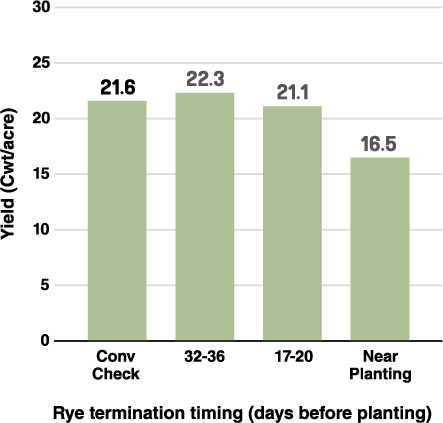
Using a Rye Cover Crop as Forage
The forage value of rye is similar to that of other small grains when grazed or chopped while still vegetative. If the plan is to graze rye in the fall in prevent plant situations (usually only allowed after Nov.1), it should be planted in early August so that it has sufficient growth to be useful.
Do not begin grazing until the roots are well established so the plants will not be uprooted when grazed. Spring grazing may be limited due to the short duration between rye regrowth and when the cash crop will be planted. Rye can be hayed at any stage but yield will increase and quality decrease as rye matures.
In small grains, the digestible nutrients increase when the grain forms, thus the best nutritive value of hay is when harvested at the soft dough stage. However, waiting to this stage will not allow for a subsequent cash crop unless another forage is planted after rye.
Note that quality declines faster with rye than other small grains after heading. Therefore, when the plan is to have forage for hay in late spring to early summer, other small grains such as spring-planted triticale, forage oats and barley are better forage quality options than rye.
Pests and Diseases of Rye
The most common diseases found on rye in North Dakota include leaf rust (Puccinia recondita f.sp. secalis), ergot (Claviceps purpurea) and Fusarium head blight (Fusarium graminearum). The leaf rust pathogen does not overwinter in North Dakota and usually is found later during the small-grain growing season. What is important to note is that the leaf rust pathogen of rye will not infect wheat, durum or barley (Figure 4).
Rye is very susceptible to ergot. Spores infect the ovary of the potential kernel during pollination. Therefore, ergot is only important if rye is grown for grain and not if it is used as a cover crop (terminated at heading) or forage.
Ergot has a wide host range, including wheat, durum and barley. Ergot bodies (sclerotia) are the overwintering structure for the pathogen and contain alkaloids that when ingested can cause disease in humans and other animals.
Fusarium head blight of rye often occurs when the weather is warm and humid during the heading and flowering stages. This potentially could lead to Fusarium-damaged seed that will harbor vomitoxin (deoxynivalenol) and likely have reduced germination.
Rye is susceptible to wheat streak mosaic virus (WSMV) and the wheat curl mite (WCM). However, transmission of WSMV from cereal rye to other susceptible small grains by WCM is relatively low. You still may want to avoid late plantings of spring wheat (or early planting of winter wheat) near fields where rye was planted as a cover crop.
Rye as a Component of Integrated Weed Management
Rye is an important component of weed control in many organic systems. The benefits of rye are continuing to be explored as a part of integrated weed management in conventional systems. Rye often can reduce the density and biomass of many common weeds in agronomic systems, but it cannot replace traditional herbicide programs for complete weed control. Research demonstrating the weed control value of rye in no-till soybean systems has been published in locations across the Corn Belt, mid-South and eastern U.S., all locations where spring moisture is rarely a limiting factor for crop establishment.
Rye planted at rates of 45 pounds per acre or higher can reduce the density of fall and spring germinating horseweed populations in the eastern Corn Belt. Several studies have evaluated the benefit of rye for waterhemp and Palmer amaranth management. Similar to horseweed, rye can reduce density and biomass of these two important pigweed species consistently, but it does not completely control either weed.
Rye biomass of more than 1,300 pounds per acre has been effective at delaying the time these pigweeds take to grow to 4 inches in height by 16 days. In areas with widespread, multiple herbicide-resistant weed biotypes, rye can be an important integrated tool to suppress these weeds and allow for timelier postemergence applications of effective herbicides.
Rye provides weed suppression through a combination of competition and allelopathy. When rye is growing vigorously, it provides fair to good control of some herbicide-resistant weeds, including foxtail, kochia and horseweed. As an example, in an NDSU soybean trial using rye as a cover crop at Carrington, preplant (late May) foxtail and kochia control ranged from about 70% to 80% with adequate rye plant growth and density.
Rye provides some suppression to other problematic weeds such as waterhemp, green and yellow foxtail, and common ragweed. Some species are relatively unaffected by rye suppression, including members of the legume and mint (such as lanceleaf sage) families.
Once rye reaches anthesis, it ceases to provide weed suppression other than shading effects. Generally, suppressed weeds are able to germinate in the presence of rye; however, growth and development are inhibited severely until the rye reaches anthesis. Field observations among rye varieties suggest that ND Dylan and Hancock offer better suppression of kochia than other varieties.
A rye cover crop may reduce the need for a pre-emergence herbicide but should be considered a supplement to existing weed management tools. Field scouting is needed to guide the timely application of postemergence herbicides for full-season control. In an NDSU trial at Carrington, foxtail and common lambsquarters control (97% to 99%) with rye terminated after pinto bean planting was similar to control with a pre-emergence herbicide when evaluated three weeks after bean planting. Also, foxtail and common lambsquarters control was 81% and 66%, respectively, when rye was terminated five weeks before bean planting, compared with the excellent weed control with delaying rye termination until after bean planting.
Uniform plant spacing and good growing conditions are needed for weed suppression with rye. Rye quickly loses most weed suppressive characteristics following termination. Another weed management strategy is likely needed following rye anthesis or termination, although occasionally the remaining rye mulch can provide an extended reduction in weed seed germination.
Figure 5. Early termination of rye resulted in minimal weed suppression compared with later termination. In this pair of pictures, rye in the picture on the top was terminated two weeks prior to soybean planting, and rye in the picture on the bottom was terminated two weeks after soybean planting. (Joel Ransom, NDSU)
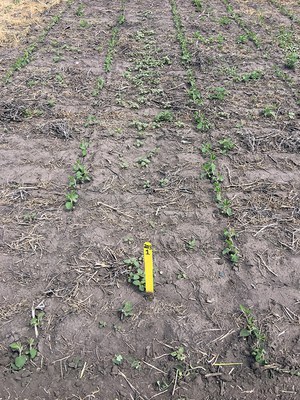
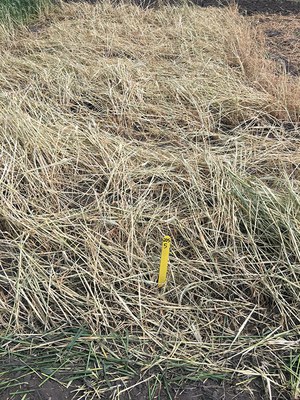
Rye Nutrient Cycling
One purpose of growing rye as a cover crop is to take up available N from the soil in the fall to minimize its loss into the environment through leaching or denitrification. Therefore, no fertilizer N applications are recommended for a rye cover crop.
The amount of N taken up by rye will depend on the biomass of the plant. Rye in the vegetative stage contains 1.5% to 3% N. Therefore, 1,000 pounds of rye biomass would contain about 25 pounds per acre of N that it scavenged from the soil.
The timing of N release from the rye biomass (assuming it was not grazed or removed) would depend on the carbon:nitrogen (C:N) ratio in the soil and other factors. The C:N ratio of vegetative rye tissue varies from 17 to 28.
Generally, this ratio is favorable for rapid mineralization and release of N. However, recent research in North Dakota, Wisconsin and other Midwest/Great Plains states indicates that degradation release of N to the next crop does not happen.
Some evidence indicates that perhaps the N is being fixed by smectitic clays during dry periods, and release may be very slow. The C:N ratio of the mixed-species cover crop including rye, other small grains and broadleaf cover crop species including legumes is not an indicator of N release to the immediately subsequent crop.
The data summarized in Figure 6 resulted from an experiment in which corn was planted after a 4,000+ pounds per acre mixed-species cover crop, including volunteer winter wheat, forage radish, forage turnip, flax and field peas, that was grown following winter wheat in 2016. The N rate in the cover crop treatment necessary to achieve the 0 N rate in the no-cover crop treatment was roughly the N that was taken up by the cover crop.
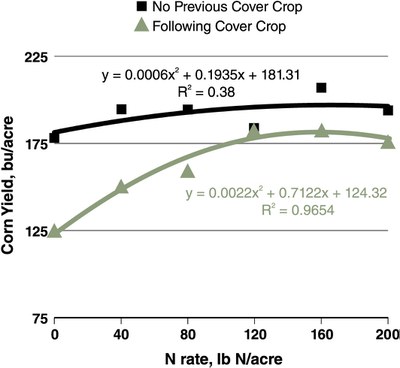
- Figure 6. Effect of N rate on corn yield when following a mixed cover crop the previouis season, Rutland, N.D., 2017.
Summary
Rye has many characteristics that make it a good choice for use as a cover crop in North Dakota. Best management practices for growing rye will depend on the purposes for growing a cover crop and the crops that will follow.
Establishing a uniform stand and producing adequate levels of biomass before winter freeze-up and/or before termination in the spring are important goals for producers. Seeding rates should be adjusted depending on the sowing date, whether it is broadcast or incorporated into the soil and whether it will be mixed with other species.
The balance between delaying termination to accrue more biomass and earlier termination to minimize potential yield impacts on the following crop needs careful consideration, especially when rainfall is limited in the spring. Although a well-established rye cover can reduce weed emergence and growth, herbicides still will be needed for acceptable season-long weed control in conventional systems.
Rye has the potential for extracting significant levels of N from the soil that might otherwise be lost, but this sequestered N will not be immediately available to the following crop.
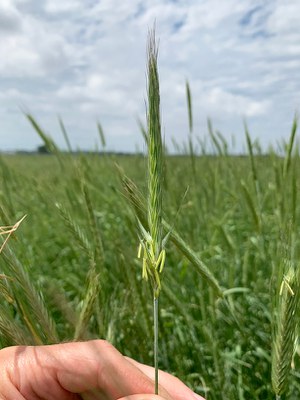
Acknowledgments
Data presented here was from research funded in part by U.S. Department of Agriculture-National Institute of Food and Agriculture award No. 2016-69004-24784; the North Dakota Soybean Council; the Northarvest Bean Growers Association; the Minnesota Wheat Research and Promotion Council; and the Minnesota Soybean Research and Promotion Council.

